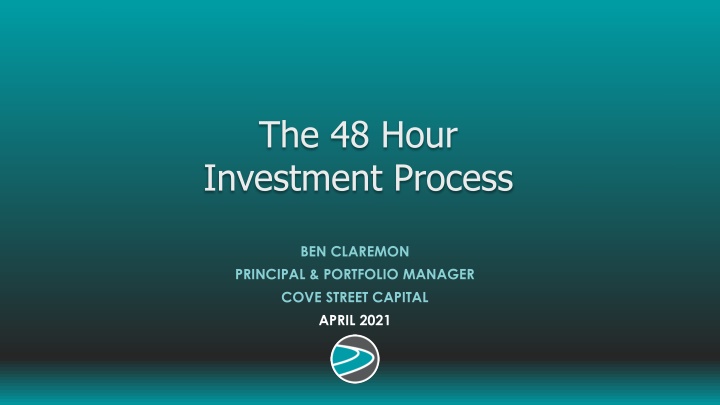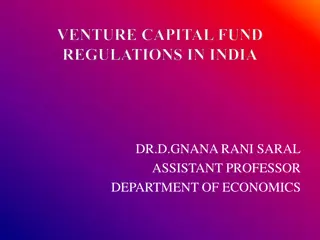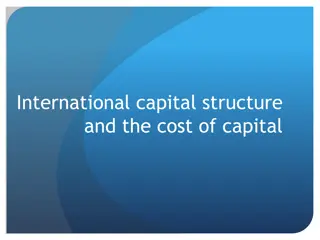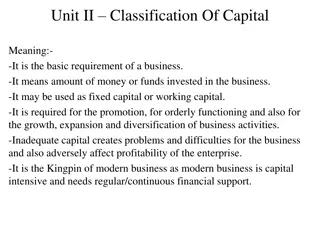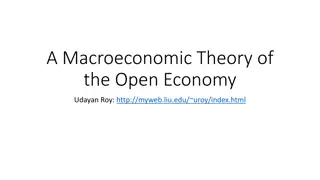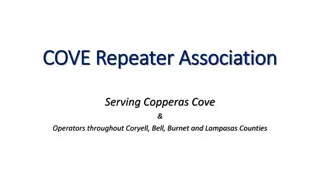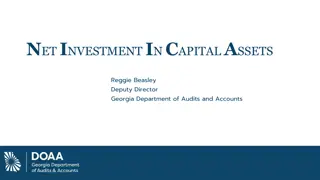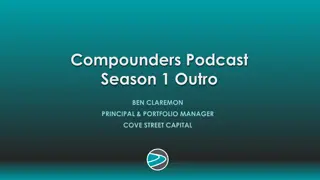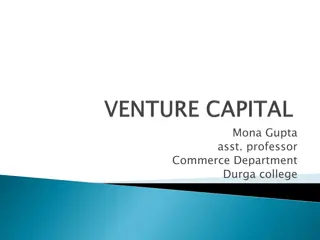The 48 Hour Investment Process at Cove Street Capital
Explore the investment philosophy and process at Cove Street Capital through the lens of Principal and Portfolio Manager Ben Claremon. Learn about fundamental value investing, key investment questions, and why it matters to job seekers in investment management.
Download Presentation

Please find below an Image/Link to download the presentation.
The content on the website is provided AS IS for your information and personal use only. It may not be sold, licensed, or shared on other websites without obtaining consent from the author.If you encounter any issues during the download, it is possible that the publisher has removed the file from their server.
You are allowed to download the files provided on this website for personal or commercial use, subject to the condition that they are used lawfully. All files are the property of their respective owners.
The content on the website is provided AS IS for your information and personal use only. It may not be sold, licensed, or shared on other websites without obtaining consent from the author.
E N D
Presentation Transcript
The 48 Hour Investment Process BEN CLAREMON PRINCIPAL & PORTFOLIO MANAGER COVE STREET CAPITAL APRIL 2021
Safe Harbor 2 The opinions expressed herein are those of Cove Street Capital, LLC and are subject to change without notice. Past performance is not a guarantee or indicator of future results. Consider the investment objectives, risks and expenses before investing. o The information in this presentation should not be considered as a recommendation to buy or sell any particular security and should not be considered as investment advice of any kind. You should not assume that the security discussed in this report is or will be profitable, or references we make in the future will be profitable or equal the performance of the security discussed in this presentation. The report is based on data obtained from sources believed to be reliable but is not guaranteed as being accurate and does not purport to be a complete summary of the available data. o Cove Street Capital, LLC is a registered investment adviser. More information about us is located in our ADV Part 2, which is on our website or upon request; http://covestreetcapital.com/faq/ o
Presentation Overview* Why this matters to YOU Things to do BEFORE you start researching Checklist on how to get up to speed quickly: Business Value People How to think about a recommendation Other avenues available if you have more time Key takeaways Q&A 3
Presenter Biography 4 Ben Claremon Ben Claremon joined Cove Street in 2011 as a research analyst. He also serves as a Co-Portfolio Manager for our Classic Value | Small Cap Plus strategy. Previously he worked as an equity analyst on both the long and the short side for hedge funds Blue Ram Capital and Right Wall Capital in New York, and interned at West Coast Asset Management in Santa Barbara. Prior to that, he spent four years with a family commercial real estate finance and management business. Mr. Claremon was also the proprietor of the value investing blog, The Inoculated Investor. His background includes an MBA from the UCLA Anderson School of Management and a BS in Economics from the University of Pennsylvania s Wharton School.
Investment Philosophy 5 o Classic fundamental, research-driven value investing o Concentrate on best ideas o Buffett vs. Graham framework o Think and act long-term oMathematics of compounding o Less is more o Key investment questions: o Is this a high return company that is getting more valuable each day? o Is this company run by honest people who understand capital allocation? o Is the stock undervalued based on conservative assumptions about the future?
Why are we here? 6 If you are interviewing for a job in investment management, you might be asked to turn around a stock in 48 hours Real world example: FPA and Big Lots (BIG) Even if you are going into i-banking, having an expedited process will be helpful Good way to filter out what you shouldn t spend time on at work or for your own PA You will be honing your process the rest of your career Develop the ability to quickly figure out what not to spend time on This truncated process is not the only way other investors will have a different process But there should be elements you can take away
But, before you even start 7 What is the purpose of this process? Job interview New project at work Looking for investments for your PA Helping family/friend/spouse understand a potential employer or investment What is your own personal objective? Get a job, impress boss/colleagues, improve your process, make $, etc. What is your boss/potential employer looking for?
8 Poll # 1 What is your desired job/industry post-graduation? A) Investment management B) Investment banking C) Consulting D) Other
Job interview scenario 9 What is the firm/fund looking for? Unlikely to make an investment decision based on your work Not looking for a full analysis/model/recommendation If they are looking for a recommendation => red flag? They want to understand your process and HOW you think about investing Do you have the skills/knowledge/passion to contribute? Do you think like an analyst or a PM? IMHO: Always put on the PM hat Is there anything special or unique about you? Business, value, people is a great framework from which to start Thoughtfulness > Precision; Curiosity > Certainty Think about what else you would do if you had more time Be creative: call IR or message someone on LinkedIn--why not?
New project at work scenario 10 What is your boss looking for? Not looking for a full analysis/model/recommendation If they are looking for a recommendation => red flag? Should we spend more time on this company? Is this a Buffett or a Graham stock? Do we have the internal ability to develop an edge? Is this the kind/type of company we invest in? What other research outlets are there for us? Want you to think like a PM how would this stock fit into a portfolio? Business, value, people is a great framework from which to start Thoughtfulness > Precision; Curiosity > Certainty
11 Poll # 2 On which of these topics do you think you should start your analysis? A) People B) Value C) Business
General process advice 12 Take NOTES as you dig and read! (Don t be lazy) Start a Word doc or use Slack You will want to refer to things you come across later and you don t want to rely on your memory Copy and paste valuable charts and graphs as well Write down questions that come up as you go Think about the 4 key variables that will determine the success of the investment Have a game plan that involves a checklist This presentation + assessing management presentation = good start Get access to a high-quality data site Don t go down unnecessary rabbit holes Recognize that you won t know everything or understand every detail Always keep in mind: B, V, P
13 BUSINESS
Assessing the Business There are many variables/factors you can focus on but here are 10 things you can start with: How does the company make money? What are the company s products and services? Who are its main customers and competitors? Where does it have to invest over time? Does it generate good margins and returns? What are the growth opportunities? End markets growing? Where is there room to become more profitable/efficient? How does this business finance itself? Does this company have a sustainable competitive advantage that allows for either lower costs or consistent pricing power? What are the main threats and risks to the business? 14
15 Poll # 3 Which document or source is best to start with when first looking at a company? A) Sell side report B) Company presentation C) Proxy D) 10-K/Annual Report
Assessing the Business Checklist of where to start to answer these questions: 16 10-K/Annual Report: almost always the best place to start Company overview section Products/services Differentiation and strategy End markets Competitors Customers Risk Factors: mostly legalese but look for outliers Management Discussion and Analysis (MD&A): how has the business performed recently? Financial Statements Cash flow statement is king Notes Don t worry about things such as revenue recognition or goodwill accounting Chairman or CEO Letter: always worth reading for context Company conference presentations: transcripts and PowerPoints Company website: can have a treasure trove of information
Assessing the Business Where else to go to answer the 10 questions: Sell-side initiation report available? Can offer a very helpful overview But beware inherent bias and of price targets Recent quarterly conference call transcripts Other web-based content: Industry primers Write-ups from other investors (e.g. Seeking Alpha or Value Investors Club) Proceed with caution Industry blogs and trade magazines 17
Assessing the Business So, you have done an initial dive but now what? Go back through your notes This is how you start to create a narrative See if you can answer the 10 questions If you can, write down your answers If not, find new sources to get answers Time to move from information gathering to critical analysis and skepticism 18
Assessing the Business 19 You need to make a call on business quality Margin and return analysis: ROIC > WACC? If yes by how much? If no why would it get better? Margins and returns versus closest comps (more on next slide) Barriers to entry, moat, switching costs, network effects, capital intensity Buffett versus Graham? C-PEST analysis Climate, political, economic, social, technological threats and opportunities Incremental ROIC high as well? Secular tailwinds or threats? Cyclical issues? Can you say for sure the business is getting more valuable each day? If you could not trade the stock, would you be happy to own it over the next 3 years? 5 years? 10 years? Ignoring valuation is this a stock you WANT TO OWN?
Assessing the Business Is ROIC >WACC? There are a lot of ways to calculate returns ROE 20 Return on tangible capital NOPAT/Capital Employed (Cove Street s preferred ROIC) ROA Do you include intangibles and goodwill or not? Simple advice: Use multiple metrics and do noy rely on just one Try to figure out what is appropriate for the industry If the returns are close to WACC, err on the side of caution Assume it is a Graham until proven otherwise Look deeply at industry structure More consolidated likely higher margins/returns Less consolidated potential room for more consolidation How ripe for disruption is the industry as a whole?
Assessing the Business Margins and returns versus closest comps Compare segment by segment if you can (see below) Otherwise, compare margins and returns at the company- level 21
22 Poll # 4 How important is the balance sheet and leverage when first looking at a company? A)Not so much, the business is WAY more important B)Very important because leverage can destroy a business C)Valuation is really what VALUE investors should focus on
Assessing the Business Quick Balance Sheet Review A few key metrics: Net debt to EBITDA EBITDA/Interest Expense (EBITDA-CAPEX)/Interest Expense Does the business generate cash consistently? Nearest maturities Covenants Other funding requirements: dividends, buyback, M&A, legal settlements, environmental costs, etc. Every company and industry is different So, the B/S risk is dependent and subjective 23
Assessing the Business Ben s Proprietary Debt Score Make a call about the risk of the B/S 24
25 VALUE
Why is valuation so important 26 As an investor, all you can control is: Your due diligence process The price you pay Academic research says valuation really matters when it comes to future returns Core skill of being an equity analyst Allows you to employ creativity Building consistency is key to a good process
27 Poll # 5 What valuation metric should you be most focused on? A)P/E ratio B)EV/EBITDA C)Sum of the parts D)DCF E)All of the above
Key Valuation Techniques 28 DCF Historical Multiples Analysis SOTP Private Market Value TRIANGULATE!! You want multiple metrics that suggest that the stock is trading below intrinsic value But no bell goes off when you hit a stock s intrinsic value
Discounted Cash Flow Analysis (DCF) 29 The value of ANY company is equal to the present value of future cash flows The difficulty is properly understanding what the future will look like This is why you have to perform deep diligence on the business: Competitive advantage Total addressable market Incremental returns on capital Margin/return enhancement opportunities Capital allocation avenues Garbage in= garbage out Any stock can be cheap or expensive based on assumptions Multiples are simply short hands for a DCF Great presentation from NYU professor on marrying the narrative and model: http://people.stern.nyu.edu/adamodar/pdfiles/country/narrative&numbers.pdf
DCF (cont.) 30 Cove Street s Conservative DCF Assumptions Risk free rate = 5% Far higher than current 30 Year UST Think of WACC as a minimum level of return you would accept as an equity investor Long term market returns of 6-7% so acceptable WACC > market returns We are not alone Joel Greenblatt: https://www.theinvestorspodcast.com/episodes/common-sense- investing-w-joel-greenblatt/ Terminal growth rate = 0% Modest growth expectations years 5 to 10
DCF (cont.) 31 DCF Example: Western Union (WU) Stock Price: $24.45
Quick and Dirty Model 32 Income Statement Revenue Ideally driven by a metric such as subscribers Forecast out subs and revenue/sub Gross margins Tells you a lot about the quality of the business Operating Income and Operating Margin EBITDA (necessary for PMV and SOTP values) and EBITDA% Tax Rate EPS Cash Flow Statement D&A Changes in working capital CAPEX and Maintenance CAPEX Option expense These are the building blocks to get NOPAT
Historical Multiples 33 We use Capital IQ to determine the standard deviation adjusted average multiples for every company 5, 10, 15 year average if available Apply the chosen multiple to 3 year out EV/EBITDA, P/E, EV/Sales multiples Include cash generated over that period (for EV-based calcs) to determine the value in 3 years WU Multiples
Historical Multiples (cont.) 34 WU Multiple Analysis:
Sum-of-the-parts (SOTP) 35 If company has multiple segments: Find public comps for each of the segments Apply those multiples to the various segments Can use precedential transactions as well Add discount or premium based on business quality vs. peers Be very careful if there are no/few perfect comps; beware inflated multiples Sum up the various parts, subtract debt => equity value LUMN Example
Private Market Value 36 What would this company be worth if it were sold today? Look for precedential transactions Either apply those multiples to segments or whole company Add discount or premium based on business quality vs. peer Understand where you are in the cycle and when the deals were completed Again, be very careful if there are no/few perfect comps; beware inflated multiples Understand differences that stem from: Margins Returns Growth profile Geographic exposures Where the stock is traded Size and scale Strategic vs. private equity acquirer
Combining Valuation Techniques 37 Triangulate value Again, what you want is multiple metrics that suggest undervaluation If one doesn t scream cheap=> not necessarily a deal breaker Make sure you are consistent in your assumptions across techniques Use the DCF to test your assumptions: What is the current stock price implying about growth/margins? Is that reasonable or unreasonable? Too conservative => you miss opportunities Too bullish => you LOSE money First rule is don t lose money Demand a sufficient margin of safety for the risk you are taking Make sure you have a contrarian thesis on why the market is wrong at the current valuation
38 PEOPLE
Understanding the People 39 This is a topic I covered in depth in my Applied Value Investing presentation Let me know if you want the slides or my personal management scorecard Major things to consider: Have to assess prior capital allocation M&A, buybacks, dividends, divestitures, R&D spend, CAPEX Read the proxy to understand incentives ST and LT compensation: what metrics do they use? Payout in a change in control scenario Board and management red flags Does compensation feel excessive? Does management hit the goals and targets it sets out? How long they have been there and previous experience How have financial results and stock price performance been over time? Be skeptical but make a call on management: friend, foe or neutral
40 Poll # 6 Which is the most important of the three components of ESG? A)Environmental B)Social C)Governance
ESG (Environmental, Social, Governance) 41 But wait, how does ESG fit? There is no good E & S without good G Everything starts with good corporate governance Good management teams anticipate changes and invest for the long run Focus on E&S comes from the top but has to be part of the culture Will be hard to know a lot about ESG in a short period of time Have to follow a company and an industry for a while Focus on governance if you are time constrained Look at Indeed and Glassdoor to get a sense for culture (the S part) Do they publish an annual CSR or ESG report? If so, read through it Ascertaining the E can be tough as well So many different reporting standards Do you reward companies that have low scores but are improving? Tech companies score high on environmental but how about social? There are some questions I ask myself (next slide)
10 Questions on the E of ESG 42 If you see a lot of yeses that is not a good sign Look for things that stand out as potential negatives Cheap valuation may not be enough to protect you from these issues You may question the longevity of the company or the returns You may wonder if management has done enough Capital allocation? Risk management? No hard and fast rules exactly this is a red flag analysis ESG is a hot space so BEWARE greenwashing by companies
43 PUTTING IT ALL TOGETHER
Risk Factors 44 Pay special attention to what can cause you to lose money First and second rule of investing Be your own short Create 4-5 short points for why this will not be a good investment Remember there are lots of ways to lose money (see next page) Markets are relatively efficient you better have a good reason to be a contrarian There are a lot of stocks that are cheap for a reason What is going to be different going forward? Would you rather buy Tootsie Roll (TR)? Approach every investment with skepticism and humility Look for reasons NOT to recommend/own the stock Other people appreciate you highlighting the risks But also try to be optimistic about the future (because stocks do go up over time) This is a tough balance
Risk Factors These are a few very good ways (in our experience) to lose money: 45
Developing a Contrarian Thesis 46 Be careful not to parrot the management or sell-side pitch Have to be different from consensus Write down your narrative for what needs to happen for the stock price to be a lot higher in 3 years Make sure you have identified the 4 key variables What is your view on how each will play out over time? If 10 things have to go right to make money red flag Think in terms of base rates What are you thinking that others aren t? What aspects of the company might be underappreciated? Is it possible to develop an informational edge? Potential catalysts to value creation
47 Poll # 7 What is the most important personal characteristic when it comes to being a good investor? A)Humility B)Optimism C)Contrarianism D)Skepticism E)All of the above
Making a recommendation (?) 48 First, find a way to highlight the work you have done Marrying the qualitative and quantitative Discuss the depth of the process Remember the expectations associated with the analysis (slides 9 & 10) Hard/impossible to get conviction in 48 hours (or even a week) IMHO: don t make an investment recommendation but do opine on: Is this a company you would like to own at any price yes or no? Does it appear to be trading at a large discount or not? At what price would it be more interesting? Is this a business you would be willing to pay up for? What do you think of the people: friend, foe or neutral? What further work would you like to do to learn more? Put yourself in the shoes of a portfolio manager not just a stock analyst
Other future research avenues 49 Talk to IR/management Learn to ask what if questions that make people think outside the management script Contact former employees on LinkedIn Try to understand management style and company culture Great way to understand the competitive dynamics Attend an event from an industry trade show or conference (Sparingly) talk to other investors who are either long or short the stock Use expert networks if you have the resources
Other future research avenues 50 Use the product/service or visit a store/facility Download the company s app and try to use it Sign up for a product demo Read through relevant filings and calls of other public companies: Competitors, customers, suppliers Talk to the IR/management of the competitors Talk to the IR/management of major customers or suppliers Find government people to talk to about the company Go visit the company s HQ and get a tour
